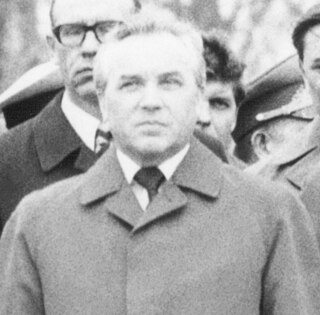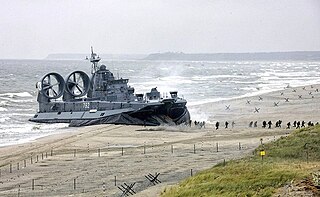Related Research Articles

Nuclear warfare, also known as atomic warfare, is a military conflict or prepared political strategy that deploys nuclear weaponry. Nuclear weapons are weapons of mass destruction; in contrast to conventional warfare, nuclear warfare can produce destruction in a much shorter time and can have a long-lasting radiological result. A major nuclear exchange would likely have long-term effects, primarily from the fallout released, and could also lead to secondary effects, such as "nuclear winter", nuclear famine, and societal collapse. A global thermonuclear war with Cold War-era stockpiles, or even with the current smaller stockpiles, may lead to various scenarios including the extinction of the human species.

World War III, World War 3, WWIII, WW3, or the Third World War are the names given to a hypothetical global conflict subsequent to World War I and World War II. The term has been in use since as early as 1941. Some apply it loosely to limited or more minor conflicts such as the Cold War or the war on terror. In contrast, others assume that such a conflict would surpass prior world wars in both scope and destructive impact.

Grigory Vasilyevich Romanov was a Soviet politician and member of the Politburo and Secretariat of the Communist Party of the Soviet Union. In 1985, he was considered Mikhail Gorbachev's main rival in the succession struggle after the death of Konstantin Chernenko in March 1985, the third Soviet leader to die in just a few short years.

Vladimir Aleksandrovich Kryuchkov was a Soviet lawyer, diplomat, and head of the KGB, member of the Politburo of the Central Committee of the CPSU.

A military exercise, training exercise, maneuver (manoeuvre), or war game is the employment of military resources in training for military operations. Military exercises are conducted to explore the effects of warfare or test tactics and strategies without actual combat. They also ensure the combat readiness of garrisoned or deployable forces prior to deployment from a home base.
On September 11, 2001, the North American Aerospace Defense Command (NORAD) was involved in an ongoing operation which involved deploying fighter aircraft to northeastern North America. The U.S. Military and NORAD had also planned to conduct several military exercises and a drill was being held by the National Reconnaissance Office, a Department of Defense agency. The operations, exercises and drills were all canceled following the September 11 attacks.
Able Archer 83 was a military exercise conducted by NATO that took place in November 1983. It simulated a period of heightened nuclear tensions between NATO and the Warsaw Pact, leading to concerns that it could have been mistaken for a real attack by the Soviet Union. The exercise is considered by some to be one of the closest moments the world came to nuclear war during the Cold War. It was the annual Able Archer exercise conducted in November 1983. The purpose of the exercise, like previous years, was to simulate a period of conflict escalation, culminating in the US military attaining a simulated DEFCON 1 coordinated nuclear attack. The five-day exercise, which involved NATO commands throughout Western Europe, was coordinated from the Supreme Headquarters Allied Powers Europe (SHAPE) headquarters in Casteau, Belgium.

Seven Days to the River Rhine was a top-secret military simulation exercise developed at least since 1964 by the Warsaw Pact. It depicted the Soviet Bloc's vision of a seven-day nuclear war between NATO and Warsaw Pact forces.

The Cold War from 1979 to 1985 was a late phase of the Cold War marked by a sharp increase in hostility between the Soviet Union and the West. It arose from a strong denunciation of the Soviet invasion of Afghanistan in December 1979. With the election of Prime Minister Margaret Thatcher in 1979, and American President Ronald Reagan in 1980, a corresponding change in Western foreign policy approach toward the Soviet Union was marked by the rejection of détente in favor of the Reagan Doctrine policy of rollback, with the stated goal of dissolving Soviet influence in Soviet Bloc countries. During this time, the threat of nuclear war had reached new heights not seen since the Cuban Missile Crisis of 1962.
Operation RYAN was a Cold War military intelligence program run by the Soviet Union during the early 1980s when they believed the United States was planning for an imminent first strike attack. The name is an acronym for Raketno-Yadernoe Napadenie. The purpose of the operation was to collect intelligence on potential contingency plans of the Reagan administration to launch a nuclear first strike against the Soviet Union. The program was initiated in May 1981 by Yuri Andropov, then chairman of the KGB.
On 26 September 1983, during the Cold War, the Soviet nuclear early warning system Oko reported the launch of one intercontinental ballistic missile with four more missiles behind it, from the United States. These missile attack warnings were suspected to be false alarms by Stanislav Petrov, an engineer of the Soviet Air Defence Forces on duty at the command center of the early-warning system. He decided to wait for corroborating evidence—of which none arrived—rather than immediately relaying the warning up the chain of command. This decision is seen as having prevented a retaliatory nuclear strike against the United States and its NATO allies, which would likely have resulted in a full-scale nuclear war. Investigation of the satellite warning system later determined that the system had indeed malfunctioned.

Leonard Harry Perroots, Sr., USAF was Director of the Defense Intelligence Agency from October 1985 to December 1988. He retired January 1, 1989. In 1989, he was hired by Donald Mayes to become president of Vector Microwave Research Corporation, an enterprise performing tasks and dealings for the CIA and the U.S. military. While serving as assistant chief of staff for the U.S. Air Forces in Europe, he is credited with helping to avert a nuclear war with the Soviet Union during the Able Archer 83 war scare. Perroots died on January 29, 2017, at the age of 83 following a short illness.

The Zapad 2009 military exercise was held by the armed forces of Russia and Belarus in Belarus from 8–29 September 2009. According to several reports and analyses, the exercise could have involved training for the use of nuclear weapons, and might have simulated a nuclear strike on a NATO country.

Operation Deep Water was a 1957 NATO naval exercise held in the Mediterranean Sea that simulated protecting the Dardanelles from a Soviet invasion. By controlling this bottleneck in a war situation, the Soviet Black Sea Fleet would be prevented from entering the Mediterranean.
The Warsaw Pact Early Warning Indicator Project was a highly classified US and Allied program designed to gather intelligence that would provide indicators of impending Soviet nuclear attacks before they occurred. It was the American analogue to Operation RYAN. The project aimed to observe and find ways to prevent conflicts with the Soviet Union and its allies from the Warsaw Pact. It consisted of intense clandestine reporting, and Indicator and Warning Methodology.
Proud Prophet was a war game played by the United States that began on June 20, 1983, and was designed by Thomas Schelling. The simulation was played in real time during the Cold War. Proud Prophet was essentially played to test out various proposals and strategies, in response to the Soviet Union's military buildup. There were advocates for a number of strategies, which varied from demonstration nuclear attacks, limited nuclear war, and decapitation attacks. It was not possible for the United States to pursue each of these strategies. President Ronald Reagan and his administration were faced with the dilemma of figuring out how the United States should respond to the Soviet Union's large nuclear programs, while finding which strategy would be most effective.

A nuclear close call is an incident that might have led to at least one unintended nuclear detonation or explosion, but did not. These incidents typically involve a perceived imminent threat to a nuclear-armed country which could lead to retaliatory strikes against the perceived aggressor. The damage caused by international nuclear exchange is not necessarily limited to the participating countries, as the hypothesized rapid climate change associated with even small-scale regional nuclear war could threaten food production worldwide—a scenario known as nuclear famine. There have also been a number of accidents involving nuclear weapons, such as crashes of nuclear armed aircraft.
Zapad-99 exercise was a large scale military exercise conducted in June 1999 and its results forced Russia to adapt a new defense concept.
References
- ↑ "Exercise Able Archer 83 After Action Report" (PDF). Seventh Air Division . Retrieved 11 November 2013.
- ↑ Beth Fischer, Reagan Reversal, 123, 131.
- ↑ Benjamin B. Fischer (March 17, 2007). "A Cold War Conundrum: The 1983 Soviet War Scare". Central Intelligence Agency. Archived from the original on January 14, 2009. Retrieved September 26, 2015.